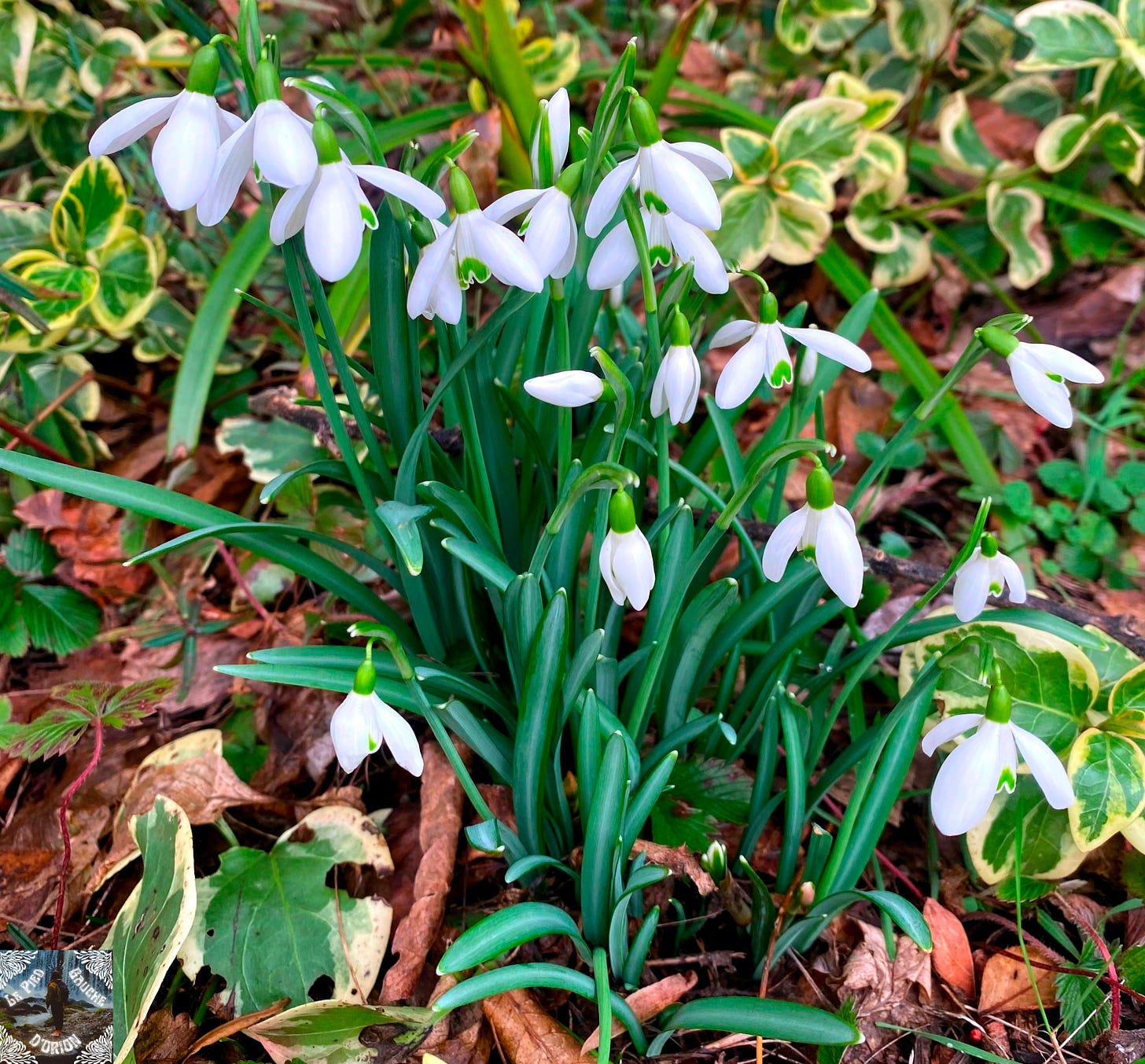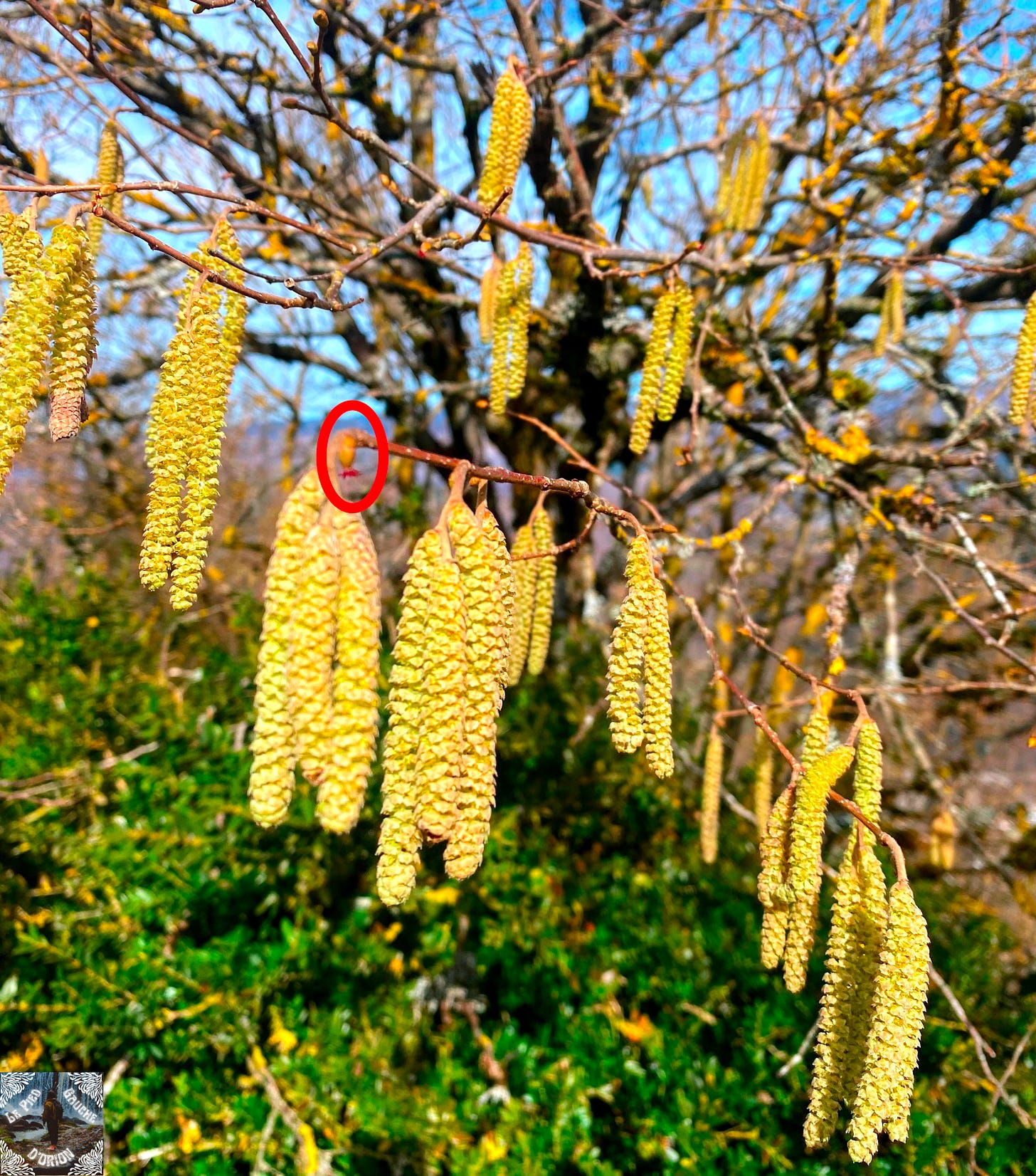A plant to ally with in spirit for this late winter
Snowdrop – Galanthus nivalis
Family of the Amaryllidaceae
Botanical Information
You may have come across the Snowdrop (Galanthus nivalis) between Candlemas and early March—it has returned to announce the end of the dark season. This small, perennial bulbous plant, about 20 cm tall, blooms as winter fades. Its delicate white bells can emerge from a blanket of snow, hence its common name.
All parts of the plant are toxic, with the bulb being the most poisonous. It is crucial not to mistake it for wild garlic or chives. Snowdrops contain galantamine, an alkaloid used to treat Alzheimer’s disease by improving cognitive function. Interestingly, this alkaloid can also serve as an antidote to atropine poisoning. Curiously, the Snowdrop—symbol of returning light—is the antidote to the poison of plants associated with the night, the nightshades (Solanaceae family), such as belladonna and datura.
Floriography
In the Victorian language of flowers, the Snowdrop represents consolation, hope, and purity, as well as offering support to a friend in distress. According to the French Federation of Artisan Florists, gifting a Snowdrop conveys a wish for "endurance and everlasting happiness."
Folklore, Mythology & Poetry
Despite its hopeful symbolism, this little flower is closely linked to death in Britain. Bringing Snowdrops into a home is believed to foretell a family member’s passing within the year. This superstition stems from its shape, which evokes a procession of wandering souls, as well as its toxicity.
In Catholic folklore, the Snowdrop is associated with the Virgin Mary, who, according to tradition, underwent purification at the Temple of Jerusalem forty days after the birth of her son—an event commemorated at Candlemas. This connection has earned the Snowdrop its vernacular French name, Violette de la Chandeleur (Candlemas Violet).
A German folktale attributes the whiteness of snow to the Snowdrop. The story tells of snow, which once was colorless, asking God for a hue. God instructed it to choose from among the flowers, but each turned away, reluctant to share its essence. Only a small flower offered its white shade. In gratitude, snow granted the Snowdrop the privilege of blooming first, even surviving beneath its frosty veil. This tale may be the root of the Snowdrop’s association with friendship, support in hard times, and resilience.
In Celtic mythology, the Snowdrop is linked to the goddess Brigid. As the story goes, she pricked her finger while battling Winter—an armored sylvan figure clad in holly—who refused to yield his rule, determined to keep bears, dormice, and squirrels in hibernation. Drops of her blood fell onto the snow, melting it, and from the exposed earth, a Snowdrop sprouted. Moved, Winter relented and allowed Spring to take its place.
Candlemas Violet,
Push through, push through, Snowdrop,
Do you herald Candlemas,
The sun and its procession
Of songs, fruits, and flowers?
Push through, push through, Snowdrop,
For Candlemas.
— Robert Desnos (1900-1945), “Le Perce-neige” from the collection Chantefables et Chantefleurs
Gratitude to the spirit of the Snowdrop—Candle of the Virgin, friend of winter’s elements—for filling us with hope after the long nights, for inspiring us with its resilience to flourish in hostile environments, and for granting us the power to heal our fading memories in a world that urges us to forget.
Two Plants to Engage with in Body and Soul This March
Primrose – Primula vulgaris
Family of the Primulaceae
Botanical, Medicinal & Culinary Information
The Primrose (Primula vulgaris) is beginning to repopulate the edges of the woods, and right now, its leaves are at their most delicious, with a subtle aniseed flavor. Its flowers are also edible—perfect for adding a splash of color to salads.
This plant has expectorant properties, making it ideal for seasonal bronchitis. It is also mildly sedative, making it a great choice for an evening herbal tea. Antibacterial, antiviral, and anti-inflammatory, it can be consumed as a decoction, syrup, or vinegar, and can also be applied topically as a hydrosol, poultice, etc. Its flowers can be candied for pastry-making and are truly delightful.
Folklore & Magic
As the quintessential flower of spring, the Primrose is associated with renewal, fertility, love, and contentment in the language of flowers. In France, in the Sarthe region, its blossoms were thrown into a stream that newlyweds had to cross in order to secure happiness and descendants in their union. In Brittany, finding a seven-petaled Primrose was said to foretell an impending marriage.
The Primrose is also linked to artistic fertility—keeping Primrose petal powder in one's office or studio is believed to earn the favor of the Muses.
A Final Thought
Gratitude to the spirit of the Primrose for soothing our winter ailments, both in body and mind, for bringing color to still-dormant paths, and for inspiring us to cultivate joy in our lives.
Hazel Catkins – Corylus avellana
Family of the Betulaceae
Botanical & Culinary Information
The catkins of the hazel tree (Corylus avellana) are the male inflorescences of this shrub. They are edible and highly nutritious, rich in proteins and essential minerals such as calcium, magnesium, silicium, phosphorus, and potassium, as well as vitamin B.
To distinguish them from birch catkins, for example, look for the female flowers—tiny red inflorescences, as shown in the reference image.
The most classic recipe is chocolate-dipped catkins: simply melt chocolate in a double boiler, dip the catkins in, then let them dry into delicious treats. They can also be chopped and cooked in sauces to add plant-based protein, similar to tofu.
Mythology & Magic
The hazel tree is a symbol of patience and steadfastness in the pursuit of mystical knowledge—its fruits take time to mature. In the language of flowers, hazel represents revelations and communication.
This tree is linked to the lunar forces, keepers of hidden wisdom. Its branches have traditionally been used by magicians to craft wands and by dowsers as divining rods to locate water and buried treasures. The caduceus, the emblem of medicine and pharmacy, is said to have been made from hazel wood.
The Legend of the Caduceus
According to Greek mythology, Mercury (Hermes) once gifted Apollo a lyre. In return, Apollo gave him a hazel wand with the power to reconcile even the fiercest of enemies.
One day, Mercury encountered two serpents locked in battle. He threw the wand between them, and immediately, they ceased fighting, wrapping themselves around the branch in harmony. This became the caduceus, Mercury’s emblem, which later became a universal symbol of peace and healing, adopted by physicians.
Gratitude to the great and mysterious spirit of the Hazel, which nourishes us through the dark season, reveals the earth’s hidden treasures, and illuminates the forests that still await, wounded yet patient, the return of Queen Persephone
I’d love to hear your plant encounters lately, and how you interact with them ! Don’t hesitate to tell me more about it in comments.
Read you soon,
K.







